| vvvvv |
WEB-PAGE
STILL UNDER CONSTRUCTION SEPTEMBER
2024 INFORMATION ABOUT THIS SCHOOL IS IN VERY SHORT SUPPLY. IF YOU HAVE ANY COMMENTS, MEMORIES OR MATERIAL TO CONTRIBUTE PLEASE CONTACT: Auntie-Bars@chaseside.org.uk THE SAVERNAKE NURSERY & PREPARATORY SCHOOL formerly THE NURSERY SCHOOL also known as AUNTIE BAR'S 1937(?) - 1962 (?) 46 OLD CHURCH LANE STANMORE MIDDLESEX Telephone: GRImsdyke 27 STAFF Barbara Ellen Byworth ("Auntie Bar") - Owner and Headmistress Mrs Kett - Entry Class "Auntie Vi" - Entry Class 1958 "Auntie Jean" - 1958 "Auntie Mick" "Auntie Sissy" "Auntie Nineney" This was my very first school, attended from September 1952, aged 4 years 9 months, until July 1954. It was located at 46 Old Church Lane, Stanmore, Middlesex at the junction with Wolverton Road. The school was in a spacious detached house here seen from the rear in a photo taken possibly after the school had closed in the early 1960s: [photo courtesy Marie-Annick Sans-Javault] Another photo, this time of the front of the school in Old Church Lane [photo courtesy Jeffrey Owen] This detail from another photo shows the extensive frontage of the Savernake School building  [background detail from an original photo courtesy Jeffrey Owen] This time in colour! [photo courtesy Jeffrey Owen] And here's a photo of a corner near the front door on Old Church Lane: 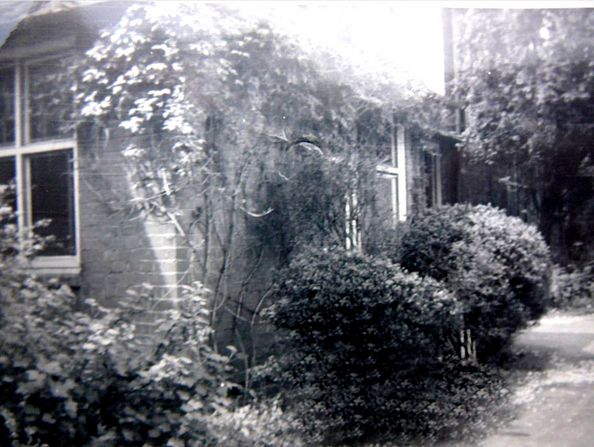 [photo
courtesy Marie-Annick
Sans-Javault]
At the back of the house was a
long garden of flowerbeds, grass
and play areas with climbing
frames, tennis court and a
sand-pit.
One
exciting feature of the garden was
that at its foot, tucked away on a
low embankment behind trees and
shrubs, was the LMR single-track
railway line from Harrow &
Wealdstone via Belmont Halt to
Stanmore Village Station which
stood at the junction of Old
Church Lane and Gordon Avenue a
few hundred yards from the school.
The passenger service to Stanmore
was discontinued during my first
term at Savernake but the track
was still used for transporting
goods, mainly coal to the
Franklins Coal Merchants depot at
the rear of the old station, and
bananas! Of course this was still
in the days of steam railways so
there were lots of exciting sounds
and smells to be enjoyed in the
garden at playtime as the
"Rattler" (as it was nicknamed)
puffed and shunted to and fro.
Stanmore Village Station "The Rattler" 1956 "Rattler Bridge" in Wolverton Road The
school was also the family home
of Headmistress, Barbara Ellen
Byworth (née Briault), "Auntie
Bar"
(1906-1995) "Auntie
Bar" in the garden at Savernake
[photo courtesy Marie-Annick Sans-Javault]
and her husband (m.
1928) Dr Harold Alfred
Byworth
(1898-1973) Dr
Byworth in the garden at
Savernake
[photo
courtesy
Marie-Annick
Sans-Javault]
The
doctor ran his General Practice
from a separate single-storey
building at the edge of the garden
with access from Wolverton Road.
The Byworths had five children:
Ruth, Simon Peter Quentin
(b.1928), Susan Wendy (b.1931,
known as Wendy), Christopher
Henry Briault (b.1939) and
Teresa (known as Tessa).Looking back I have the impression that the education provided at Savernake was ahead of its time, offering tuition in a wide range of subjects some of which one might not have expected to encounter before progressing to secondary level. For example from the very first term pupils were introduced to elementary French words and phrases. 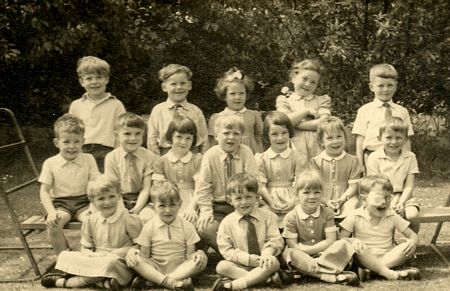 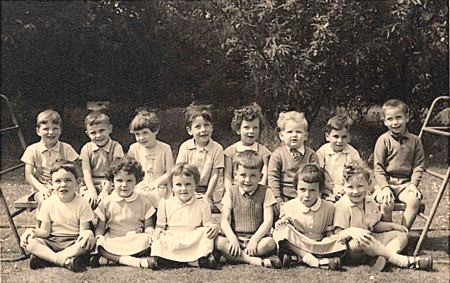 Savernake classes in the mid-1950s taken in the school gardens There was no shortage of physical activities, with movement to music, "drill" and sports, which I think consisted mostly of races, simple ball-games such as "catch" and exercises involving climbing frames and planks - as my brother has reminded me in his contribution below, this equipment was referred to as "The Apparatus". Every summer there was a "Sports Day" featuring sack races in real coal sacks, three-legged races and egg-and-spoon races balancing heavy china eggs. Nature Study often involved walks outside the school grounds, for example exploring the lane off Wolverton Road leading to the LMR railway bridge where there were hedgerows and the Stanburn stream with its tiddlers, frogs and toads and newts, and many varieties of wild plants and trees and leaves to be collected, drawn and studied. Stanburn Stream culvert in Wolverton Road today REPORTS
Examples
Please note that I have not transcribed the comments in the examples as they relate personally to the pupils concerned and are not of general interest. 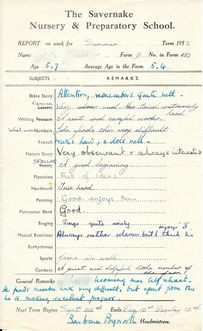 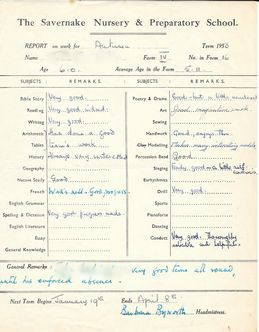 Report Categories (Some categories changed name as pupils progressed through the school) Bible Story Letters Reading Writing Patterns /Writing Numbers / Arithmetic / Tables History Geography French Nature Story / Nature Study Poetry / Poetry & Drama English Grammar / English Literature Essay Spelling / Spelling & Dictation Plasticene / Modelling Handwork Painting / Art Percussion Band Singing Musical Exercises Drill Sports Eurythmics Pianoforte Dancing Sewing General Knowledge Intelligence
Tests
Conduct General remarks Evidently prize certificates were awarded at the end of term in certain categories. I have no recollection of this myself (not being good enough, I suppose!) but here's an example of one presented in 1956 for Good Conduct: SCHOOL HOURS MORNING SCHOOL: 9.20 a.m. to 12.30 p.m.
Children in Form I finish at 12.25 p.m.
AFTERNOON SCHOOL: 2.10 p.m. to Form VI 3.50 p.m. Form V 3:45 p.m. Form IV 3:40 p.m. Forms I, II, III 3:35 p.m Children can remain at school all day and have their Midday Meal here too, in which case they will need a table napkin, two spoons, two forks and a knife (if old enough to use one without help) SCHOOL FEES (Revised as from January, 1955) PER TERM Morning School ....... 8 guineas [2023 equivalent ....... £274] Morning & Afternoon School ....... 12 guineas [2023 equivalent ....... £411] Charge for Stationery & Handiwork Materials...... 10/- [£16] Midday Dinners ....... £4. 10s. 0d. (and no rebate) [2023 equivalent ....... £147] OR £5 [£163] and a rebate of 7/6 [£12] weekly in case of absence due to illness. No rebate for absence of less than a week. One Midday Dinner per week throughout the term ....... £1 [£32] One day of Afternoon School ....... £1 [£32] or 15/- [£24] if the child is attending Dancing or Dalcroze Eurythmics Classes An occasional Midday Meal (by arrangement) without p.m. school 2/6 [£4] with p.m. school 4/6 [£8] Such meals must be paid for by cash in advance OPTIONAL EXTRAS Dalcroze Eurythmics ....... £1. 11s. 6d. [£51] Dancing ....... £1. 11s. 6d. [£51] Piano Lessons ....... £3. 3s. 0d. [£103] Yours Sincerely BARBARA BYWORTH Example of receipt for fees paid CLOTHES LISTS & OTHER REQUIREMENTS WINTER UNIFORM BOYS Grey Overcoat and/or Grey Raincoat Blue School Cap (a) and badge (b) Grey shorts Blue shirts (a) or blouses (b) (with short collars) Blue tie (a) Grey Blazer OR cardigan OR pullover Grey socks GIRLS Grey Overcoat and/or Grey Raincoat Blue beret (a) and badge (b) Blue Dayella blouses (Peter Pan collars) Grey flannel flared strap skirt with pocket NO TIE for girls Grey or blue (if very good match) cardigan Grey socks If a scarf is worn, it must
be either blue or grey in colour. Special
school scarves, hand woven in pure wool can
be ordered from the school if desired
SUMMER UNIFORM BOYS Grey shorts (of any material) Blue Aertex shirts (worn open necked) Grey socks (if any) GIRLS Special blue linen (piped white) frocks (Please make knickers to match) White socks (if any) Each child, boy or girl,
must have a white or blue sun hat, as as
much time as possible is spent in the
garden. Each child must have a pair
of white plimsolls. A bathing suit and towel
(both with loops for hanging) are also
required.
ALL TERMS Every
child must have a pair of house shoes or
slippers for indoor school wear, and a large apron or
overall, and 1 string bag, 8 x 10 . All
children staying to midday luncheon need a
table napkin and ring, 2 spoons and a knife
and fork. All children in Forms V &
VI need a satchel for their homework.
Will parents please see
that everything (especially handerkerchiefs)
is clearly marked with the child's name
(not initials) and that caps and berets have
a loop by which they can be hung up safely.
Messrs D.H. Evans, Oxford Street are the School's official outfitters. All things marked (a) can be obtained from them. For very small sizes apply to Dept. 2. Berets and other items can be obtained from Miss Saunders shop, The Broadway Stanmore Items marked (b) can be obtained from the School, i.e. the girl's blouses and little boy's blouses can be made at home from the special school blue Dayella at 7/11 per yard, which you can buy from me. I also have the berets, and badges for berets and blazers. The grey raincoats can be ordered from "Nurseryland" at Edgware or from Messrs Bourne & Hollingsworth (David Mosley grey gaberdine raincoats, or Gamages have Air Force Blue raincoats, which may be worn instead. MEMORIES
RECEIVED WITH THANKS
For my first few weeks at the school, two older Savernake girls (Lynette Tomlinson and Penny Major), who also lived in Gordon Avenue, were deputed to take me and bring me back. We walked via the private road from the bend in Gordon Avenue to Stanmore Golf Clubhouse and along the path under the railway bridge beside the Stanburn (full of sticklebacks, leeches and, in season, tadpoles), into Wolverton Road. Later I either made my own way to and from Savernake or got a lift from my father, who at that time was working at an engineering company in Dalston Gardens, off Honeypot Lane. John’s reminiscences and exhibits give a very good picture of what Savernake school was like in the early 1950s and I only have one or two things to add. The school was mixed, with roughly equal numbers of girls and boys. I don’t remember there being any male teachers. Most female staff were known as “Auntie” plus some version of their forenames. Thus, the headmistress Barbara Byworth was “Auntie Bar”. Another teacher was “Auntie Mick”. Alongside the academic and cultural subjects listed above, there was a strong emphasis on physical exercise – in suitable weather on “the apparatus”, a collection of planks and frames kept permanently in the grounds. Good use was made, too, of an enclosed tennis hard court suitable for various ball games, including netball for both boys and girls. As the last example shows, there was very little of what these days some people call “gender stereotyping”. Most boys and girls participated in most activities. That said, I can’t recall any boys doing eurhythmics – no connection with Annie Lennox and Dave Stewart, but a system of exercising to music intended to impart grace and poise. The school provided meals in a dining room around midday, but I rarely had those, as my father and I often went home for lunch. Therein lies the only bad memory I have of the school. Because when I went home to eat on 6 February 1952, I learnt of the death of King George VI, which had been announced on the radio around mid-morning. I got back to Savernake before lunch there had finished and waited on the stairs by the dining room for my fellow-pupils to come pouring out. A passing teacher saw me and assumed I had been sent out for bad behaviour. Obviously, I denied it and, as proof I had been home, told her “The King is dead”. “You’re making it up, you wicked child”, she said. “You’ll hear more about this”. I didn’t, though, not even in the form of an apology. Otherwise, I remember Savernake as a happy place, where the teachers did their best to make serious and not-so-serious learning both interesting and fun. That approach, plus the wide curriculum was, as John says, quite progressive for the era. Obviously, Savernake could not have existed if the Byworths had not been relatively well-to-do people. Dr Harold Byworth had been in medical practice long before the NHS was founded and Stanmore was not short of wealthy patients. His Rolls Royce was a familiar sight around the village and his house was large enough to accommodate both the school and the family quarters without seeming cramped, at least to us children. But Savernake was not just a rich person’s hobby. A huge amount of imagination, thought, care and dedication must have gone into the project, and for that I shall always be grateful. Adrian J Betham (attended 1947-1950). Adrian writes: One of the joys was being vociferously greeted from a passing car by Auntie Bar for years after leaving. I wish I had known she was with us for so long afterwards as I could have thanked her. My memory of the teaching was her conversing with us in elementary French. And no genderism except the self-applied one that although not dismissive of dancing class the boys did not join in. Passenger trains still ran from Stanmore Village station, I remember catching one, and they frequently passed the back of the school garden. The service was half-hourly in each direction increased to each ten minutes in peak times with trains crossing at Belmont. Living in Old Forge Close we walked down Green Lane where the later verges were of a ditch and mound so a small boy could climb up and along the ridge and down again between each of the driveways. Also to be admired were the bright new RT buses on the 114, now 340, running along Church Road and the Uxbridge Road. No bus ran down Old Church Lane except later when diverted and along Gordon Avenue when the Uxbridge Road was being widened. As I remember the new buses on the 114 those on the 142 must still have been pre-war although by the 1950's only the 113 from Edgware still operated pre-war STL's. The Stanmore Society was founded in part when it became apparent that Middlesex County Council still had on the books a scheme to dual-carriage the road from the Watford By-pass along the London Road and up Stanmore Hill to the county boundary at the Alpine. The County were still buying up and leasing back widening land whenever property changed hands. Trees survive in the strip purchased on the East side of the Hill opposite Green Lane. Former pupils included Peter Glover in my class and his younger brother Paul , children of Leslie and Rita, Leslie being the Glover of Stanmore estate agent. They lived near the top of Dennis Lane in a modern movement house and in the garden had both a swimming pool and a bomb shelter to the joy of Peter, Paul and their friends. In our class there were two Pennys, answering in unison to the call of Twopence when the register was taken. I seem to remember one or both of the Byworth sons as imprssively well on the way to being grown-up, presumably around a decade older than us. Dr Byworth was not our GP and so relatively remote but I think it was him that my father knew as a young man before the war. If so on an occasion of approaching a T-junction rather too fast he looked round to my father in the back saying "I don't think we are going to make it old boy" as he double-declutched down through the gears with the other foot on the brake, but it may have been someone else. My last contact with the school was some twenty years later noticing that an elegant young lady was looking at me in a then Bakerloo Line train waiting to leave Stanmore. You don't recognise me do you she said, going on to acknowledge that she had dyed her hair since leaving Auntie Bars and was one of the Pennys. Tony Barker (attended 1942-46). Tony writes: As far as I can
work out, I must have started during 1941/42
until I left sometime in 1946. My
brother David Barker, who was just over 2
years younger than me also started at Auntie
Bar's during the year 1943/44. We lived
with Mum and Dad in Belmont Lane, and I
remember walking to school quite often on my
own petrified of passing a house that had an
Alsatian dog which sometimes rushed up to me
and barked !
At the age of five I
arrived at Auntie Bars. After a week I
was sent to the second form, after a term I
rose to the third form, fortunately stopping
there to learn the three R's. In
addition we learned basic French at tea
parties organised by Auntie Bar. One day
queuing up for lunch I persuaded the
person next to me drink a glass of water
containing a thermometer. I didn't see
him again. I was not so lucky when a boy
dropped a brick on my finger nail in the
sandpit. I didn't see him again but the nail
is still broken. My sister Virginia
was also fated as she contracted chicken pox
on her first day at school.
Normally though we would keep fit by walking
to school from Silverstone Way, up Landsdowne
Road and along Old Church Lane - no question
of going by car. In any case my father
had the car, a second hand Wolseley 14.My very first recollection of the Nursery School was climbing the wooden staircase at the side of the house to enter through a door to the first floor where the classrooms were. My very first lesson was to learn the alphabet by being given 26 small white cardboard squares with letters of the alphabet, and placing them all in the right order. During the season when colds were about, Auntie Bar always sprinkled the classroom curtains with eucalyptus. To me it was a very pleasant smell, and somehow added to the pleasure of what I was starting to learn. Dr.Byworth was in fact our family Doctor, and I remember him calling to us at home when I was not well, always carrying his black leather medical bag. He drove around in his very posh black Rolls Royce motor car, and always looked smart in his three piece suit. A typical pleasant Doctor of that era. My grandma, Mrs Alice Russell who lived close by to us, worked for a period in the kitchen at Auntie Bars helping to cook the dinners for all the children. After lunch, everyone had to lie still and rest for a while, usually in the back garden. Sports day was always great fun. The weather fine and sunny every time. I loved all the many events and the back lawn seemed quite long to run a race to the finish. There was a great big oak tree at the bottom of the garden too. We had egg and spoon race, sack race, running race, Simon says, and I am sure there were other things which I can't at present recall. It was great fun at the end, because a trestle table was laid out with prizes for the winners to choose from. I do remember picking out a strong cardboard standup cutout of an engine with two carriages. Is that why I have a model railway layout today? I always loved the sound of ' The Rattler ' leaving Stanmore. I remember on one occasion we were having an art lesson in the classroom on the 2nd floor, when it was discovered that the door handle wouldn't work to open the door. Some of the pupils started to cry and I remember with another pupil dividing those who were crying and those who weren't into two groups. It was quite some time before the door was finally opened. I remember going out for walks in the surrounding area. We walked two together in a long line always well supervised. I remember my partner was a Judy Edwards. I have been in touch with my Brother David and he has remembered one or two names when he was there with me. They are Auntie Sissy, Auntie Nineney. Two Chinese pupils Ping Ping and Nudora, another pupil called Barbette Blackler, and Christopher, the son of Auntie Bar. He also remembers singing Jesus bids us shine, and the coloured tables we sat at for lunch using spoons and pushers. He remembers being there on D-Day and the occasions before when both he and I had to wear siren suits. He always enjoyed eurythmics. I must just mention that we later had another brother Christopher and Sister Gill, but they never attended the nursery school as we all left to live in Eastbourne in December 1946. Finally, I have found the photographs of great interest on your website, especially as I happened to visit the area in 1975 and was so disappointed to find that the Nursery School had been replaced with new houses. I do hope you find this account of my memories interesting together with the photo of my school report: 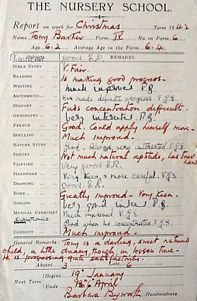 Paul Anthony Leppard (attended 1946-49) and Virginia Leppard (attended 1948-52). Paul writes: Paul Leppard also writes: Dr Harold Byworth was born in 1898 to Henry and Lily Byworth. Henry, born in 1853, was a jeweller and diamond merchant, moving during his lifetime from Clerkenwell to Woodford in Essex. He finally retired with his wife, Lily, to 53 Marsh Lane, Stanmore, presumably to be near his son and daughter-in-law. They died in their 90s. His father, James Byworth, born in 1823 in Clerkenwell, like his father George born in 1785, was a bookbinder. Barbara
Ellen Briault (Auntie Bar) was born in
Hampstead in 1906 to dentist, Ernest
Briault. His father, Lewis, born in
1842 was a diamond and manufacturing
jeweller in Clerkenwell and Islington.
His father, also Lewis, born in 1817 was a
silversmith. The Briaults are descended from
Louis Briault, born 1722 in France. Tony writes: I attended between 1955 and 1957; my younger brother 6 years later, Shunting sounds were always evident from the nearby Stanmore station (already closed to passengers before I was born) all through the mornings….chuff chuff chuff….clankk clankk clankk every few minutes. When the steam engine’s shunting work was finished, the afternoon freight train went past, alas all of this out of eyeshot. By the time my brother attended, the railway yard had all but closed, and it was a strange silence instead. Access to the school was via an outside wooden staircase on the Wolverton Road side, since the classrooms were all on the first floor. It was open and uncovered, but had wire mesh on both sides, to prevent kiddies falling through. Mrs Byworth clearly didn’t want masses of muddy feet trampling across her hallway and up the inside stairs. But she occasionally conducted senior forms’ lessons downstairs. I was once treated to one such in her lounge. It was a unique treat, with what seemed to a four year old as sumptuous and huge easy chairs. First from the outside staircase was the reception room, with other classrooms along the corridor. A wide variety of ‘learning toys’ were available for Form 1. These included a pillar box, with different wooden shapes to be inserted through the lid. It was ‘Auntie Vi’ who I remember teaching me most lessons in form IV….including how to read and write. Lunches were with a choice of three sizes, large medium or small. It was a single serving of stew or similar, probably home-made, plus a drink of water or juice. They were good times. I was sorry to leave at five, but the nearly state school of Stanburn (junior mixed and infant, as it stated) was free…or, at least, tax-paid. Money was tight, so I had no say in the matter. Former pupils (1950s) remembered by contributors: Amanda Armspach, Wanda Aulton, Adrian Betham, David Barker, Tony Barker, Kay Bell, Christopher Black, Barbette Blackler, Christopher Byworth, Jane Dennis, Peter Dunn, Richard Dunn, Judy Edwards, Peter Glover, Paul Glover, Anthea Greenwood, John Groushko, Michael Groushko, Barbara- Anne Gurshney, Paul Leppard, Virginia Leppard, Penny Major, Robert Miller, Philip Newfield, Peter Owen, Jeffrey Owen, Jonathan Petre, Tessa Phillips, Gary Reece, Lynette Tomlinson. ADDITIONAL NOTES According
to Electoral
Registers: In 1935 the
property was listed as Northumbria
(residents Henry & Kate
Ball, Ethel & Gertrude
Gregson and Sophie Ellen
Chalkley) and Northumbria
Cottage (residents
Frederick & Ada
Chalkley). In 1936 it was Savernake
(residents Harold &
Barbara Byworth, Jamesina
& Margaret McKay and
Alice Marvin). In 1937, Savernake
(residents
Harold & Barbara
Byworth, Margaret
McKay).
In 1946 "Savernake"
(residents Harold
& Barbara Byworth, Eynin
Robertson, Kathleen
Wood).
The Byworths were still in residence at Savernake Old Church Lane in 1964 but the building was not listed in 1965, presumed unoccupied if not yet demolished, and the Byworths had moved to 48 Elm Park Stanmore which they also named Savernake. A map dated 1909 identifies the Old Church Lane property as Northumbria. Dr Byworth moved his surgery to Church Road in the village centre in the 1960s, above Stanmore Wine Store at 7 Church Road. HIGHWAYS AND CLEANSING 402 HIGHWAYS AND CLEANSING COMMITTEE: 7th September, 1960. 2676.
Development at the Junction of
Old Church Lane and Wolverton
Road,
Stanmore: Culverting of
Watercourse: The Borough
Engineer reported that
planning application had been
made in respect of
redevelopment in
the grounds of Savernake
Old Church Lane, Stanmore;
that the rear of
the site has a frontage on to
a watercourse; and he
suggested that notice
be served requiring the
culverting of the watercourse.
RESOLVED:
That the Committee hereby
agree to serve notice,
pursuant to
section 262 of the Public
Health Act, 1936, upon the
owner of the land proposed
to be redeveloped at the
junction of Old Church Lane
and Wolverton
Road,
Stanmore, requiring him
to culvert the watercourse
abutting on such
land; and that the Borough
Engineer, in consultation with
the Town Clerk
on the form of the notice, be
authorised to take all
necessary action in
this matter accordingly.
[photo
courtesy Marie-Annick
Sans-Javault]
Email:Auntie-Bars@chaseside.org.uk |
vvvvv |